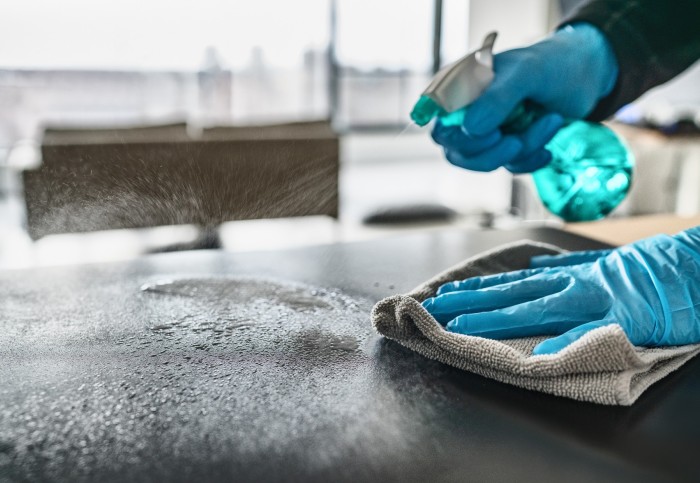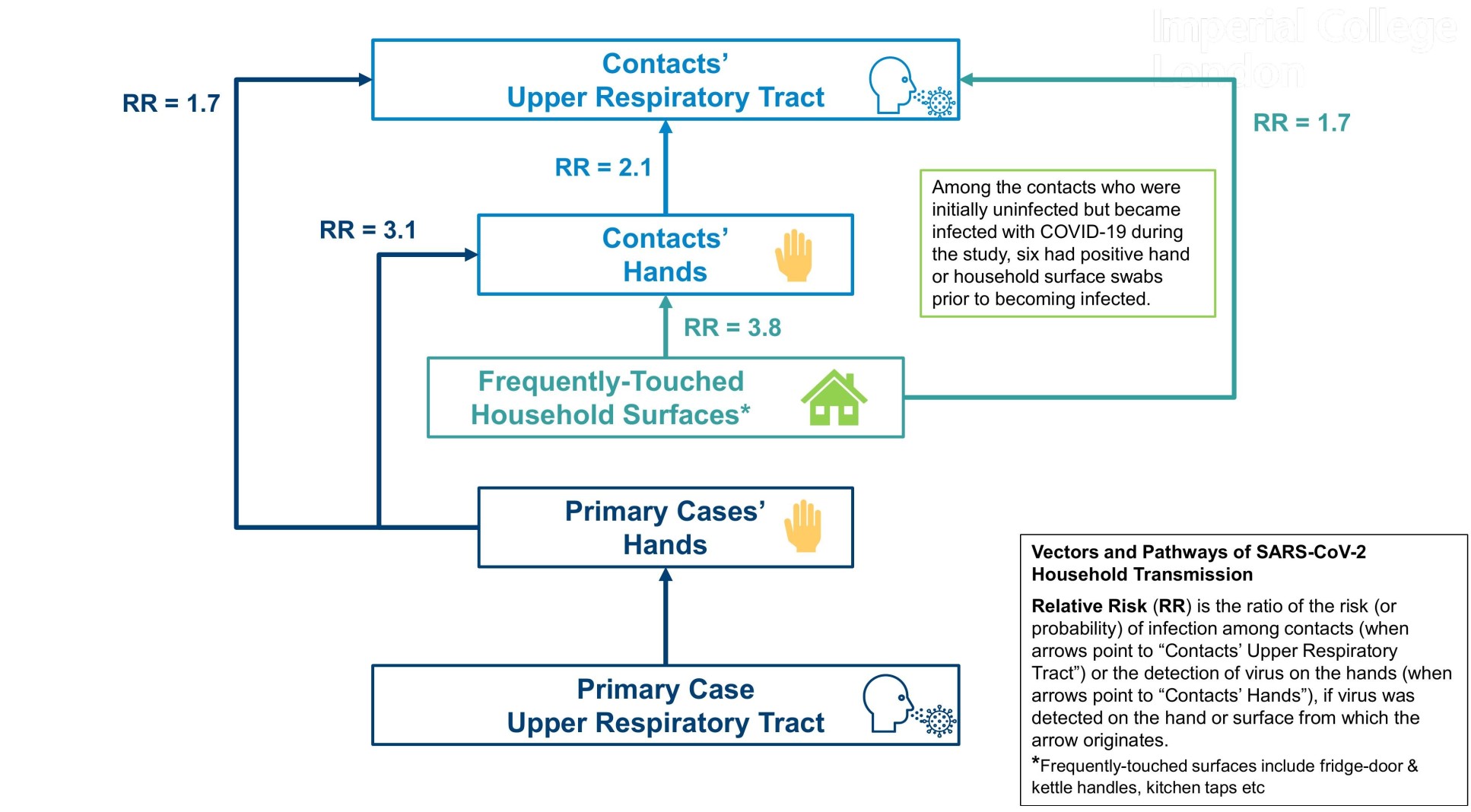COVID-19 spread in households linked to virus on hands and surfaces

A new study provides the first empirical evidence for transmission of SARS-CoV-2 via people’s hands and frequently touched household surfaces.
The Imperial College London-led research sheds new light on the spread of COVID-19 in households, where most transmission of SARS-CoV-2 occurs, and it is the first to link the presence of SARS-CoV-2 on people’s hands and frequently touched household surfaces to the risk of infection among contacts. The findings support the use of interventions at home when someone has an infection, in particular frequent handwashing, regular surface disinfection, and physical distancing as well as the use of masks to curb the spread of COVID-19.
The study of 279 households in London, published in The Lancet Microbe, was conducted at the height of the pandemic during the alpha and pre-alpha waves. The research was carried out at the National Institute of Health and Care Research (NIHR) Health Protection Research Unit (HPRU) in Respiratory Infections, a research partnership between Imperial College London and the UK Health Security Agency (UKHSA).
Professor Ajit Lalvani, lead author of the study, and Director of NIHR HPRU in Respiratory Infections, said: “There’s no doubt that if you have COVID-19 you’re emitting the virus into the air as micro-aerosols as well as large droplets that land on your hands and the surfaces around you. What hasn’t been shown, until now, is that the presence of the virus on people’s hands or household surfaces predicts transmission to contacts.
“Our real-life study in London households provides the first empirical evidence to show that the presence of SARS-CoV-2 on people’s hands and surfaces contributes significantly to spread of COVID-19. Since we didn’t systematically sample household air, we cannot rule out airborne transmission occurring in parallel.”
"In houses in which we found the virus on surfaces and the hands of participants, infection among contacts, and thus transmission, was significantly higher." Nieves Derqui School of Public Health
The first study of its kind – by researchers from Imperial College London, the UKHSA, and the University of Oxford – prospectively recruited 414 susceptible household contacts living in the same households as 279 newly diagnosed primary cases between 1st August 2020 and 31st March 2021. Since the study was conducted early in the pandemic, very few had been vaccinated or previously infected and the majority were therefore non-immune and susceptible to infection. This enabled the researchers to rigorously assess risk factors and vectors for transmission in unique circumstances akin to a natural experiment. The age range was 6-79 years, and 52% were female.
All contacts were regularly tested for SARS-CoV-2 infection by PCR on nose and throat (upper respiratory tract (URT)) swabs.
The researchers also took swabs from primary cases’ and contacts’ hands as well as the most frequently touched surfaces in communal areas (for example, fridge-door and kettle handles, kitchen taps etc.) to measure SARS-CoV-2 genetic material (RNA) and the number of virus particles. The researchers looked for correlations between microbiological detection of the virus on hands and surfaces and transmission to household contacts.
Nieves Derqui, first author for the study, from Imperial College London’s NIHR HPRU in Respiratory Infections, said: “In houses in which we found the virus on surfaces and the hands of participants, infection among contacts, and thus transmission, was significantly higher.”
Increased risk of infection
After accounting for other potentially influential factors such as sex, vaccination status, underlying illnesses, and contacts’ relationship to the primary case, the researchers found that if the virus was detected on primary cases’ hands, then contacts in their household were 1.7 times more likely to get infected than those in households where primary cases did not have the virus on their hands.

Similarly, the presence of virus on primary cases’ hands was associated with a three times greater risk of contacts in the household having a positive hand-swab, and in turn, contacts with the virus on their hands were twice as likely to become infected with COVID-19.
If virus was present on frequently touched surfaces in the household, contacts were 3.8 times more likely to have detectable virus on their hands and 1.7 times more likely to be infected, i.e. to have a PCR-positive URT-swab.
"Our data strongly suggest that as well as frequent handwashing, decontamination of frequently touched surfaces could prevent transmission." Professor Ajit Lalvani National Heart & Lung Institute
Among the contacts who were initially uninfected but became infected with COVID-19 during the study, six had positive hand or household surface swabs prior to becoming infected. This supports the directionality of transmission being from household surfaces and contacts’ hands to their nose and throat.
Whole genome sequencing of the 25 primary cases and their respective contacts where this was possible confirmed that each primary case-contact pair was infected with the same SARS-CoV-2 strain, confirming household transmission between primary cases and their respective contacts.
Professor Lalvani said: “My team’s Herculean logistical undertaking during the challenging circumstances at the height of the pandemic in real-life households strongly supports the theory that SARS-CoV-2 transmission from contaminated surfaces and hands does occur in households. With successive new variants likely to spread widely despite booster vaccinations, the simple, easily applicable public health interventions and messaging underpinned by our evidence are a valuable, risk-free and timely addition to the toolkit for living safely with COVID-19.
"Our new understanding of the pathways of household transmission now enables us to prioritise simple measures to interrupt spread of the virus. Our data strongly suggest that as well as frequent handwashing, decontamination of frequently touched surfaces could prevent transmission.”
Despite the important findings, the researchers note that this is an observational study and as such cannot prove causation. Moreover, since household air was not systematically sampled, airborne transmission cannot be ruled out.
They also acknowledge that non-white ethnicities and older age groups were under-represented in the study and their results were limited to the pre-alpha and alpha variants, so the results may not apply to other groups or more recent and infectious variants.
The study was funded by the National Institute for Health and Care Research – Health Protection Research Unit in Respiratory Infections.
‘Risk factors and vectors for SARS-CoV-2 household transmission: a prospective, longitudinal cohort study’ by Nieves Derqui et al. is published in the journal The Lancet Microbe.
Main image credit: Shutterstock.
Article supporters
Article text (excluding photos or graphics) © Imperial College London.
Photos and graphics subject to third party copyright used with permission or © Imperial College London.
Reporter
Conrad Duncan
Communications Division